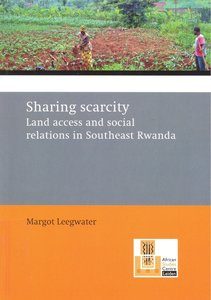Margot Leegwater ~ Sharing Scarcity: Land Access And Social Relations In Southeast Rwanda
 Introduction
Introduction
‘If there is ever violence again in Rwanda, it will be because of land’. This is what a Rwandan friend told me in February 2011, just a few weeks after I returned home from my last period of fieldwork in Rwanda. I nodded more or less intuitively in response because this was in line with what other Rwandans had told me, and some had even said ‘when’ instead of ‘if’; it was only later that I would fully grasp the seriousness of his remark. It should be read in the context of Rwanda’s post-independent history in which ethnic violence dominated, leading to a civil war (1990-1994) and culminating in the 1994 genocide that targeted the Tutsi population.
With still about 90% of the population engaged in subsistence farming, access to land is of crucial importance in present-day Rwanda (Ansoms 2009b: 299). Land remains a scarce resource in a country that has the highest population density in Africa and where many people were displaced as a result of massive violence in the past. It is estimated that the average Rwandan cultivates 0.75 ha (Huggins 2013: 1) but most peasants have only about 0.5 ha and this is spread across several small plots (Huggins 2014a: 2).[i] Because of its importance and its increasing scarcity, land has become a growing cause of conflict in recent years (Musahara & Huggins 2005; Ansoms & Claessens 2011: 4). During my first fieldwork period in 2008, respondents tended to deny or downplay conflicts over land. Although they more or less confirmed that such conflicts did exist, they rarely admitted that they had been party to any conflict themselves and always stressed that the local authorities had been able to solve these conflicts. However, during my last fieldwork period in November and December 2010, it seemed that land disputes were omnipresent. It was at this time that land registration, which was introduced in the 2005 (and later 2013) Land Law, was being carried out in the research area and my research assistant and I were often confronted with land disputes. We witnessed them when watching the demarcation procedure during land registration. They were mentioned, often without any probing on our part, by many of the people we encountered: villagers who were queuing to meet the village authority, the authorities themselves and numerous other respondents. Sometimes people even called on us for advice about solving their problems. Most conflicts that came before local mediators also concerned land and, indirectly, these conflicts often had to do with land sharing between the Hutu population and returned Tutsi refugees that took place in 1996 and 1997.
The tensions and conflicts we came across were an indication of the state of social relations among Rwanda’s rural population, which were already strained following the 1994 genocide and the ethnically-related violence that occurred around the time of Rwanda’s independence.[ii] In addition, recent, but also older, land-tenure policies like the above-mentioned land registration and land sharing seem to have had a negative impact on social relations between Rwanda’s various ethnic and social groups. The central question in this thesis is: How do government policies concerning access to land and land tenure in rural post-conflict Rwanda influence local community relations (including ethnicity) and land conflicts?
The reason why I wanted to research land issues was because I am ultimately interested in Rwanda’s current social relations and the role of ethnicity in these relationships. Land access is thus used as a lens through which to look at present-day Rwandan society and its current social tensions.
This introduction is divided into four parts. The first discusses Rwanda’s recent history and examines the 1994 genocide that targeted the Tutsi population, the issue of land scarcity and conflict and genocide-related violence. The second section takes us to present-day Rwanda and considers the nature of the Rwandan government, its strong social-engineering policies and the role ethnicity plays in social relations and politics. The third part of the chapter presents a brief introduction to the research area, the research questions and some general remarks about the research itself. It does not, however, delve into the research methods used as these are described in Chapter 2. The last section discusses the way land access is related to social relations and authority in general and applies this to the Rwandan context, before finishing with an outline of the chapters.
Download book: https://openaccess.leidenuniv.nl/ASC-075287668-3694-01.pdf?
Notes
[i] According to Huggins, statistics on the average size of land holdings vary slightly and the average size decreased by 25% between 1990 and 2000. In a 2012 report used by Huggins (2013: 1), the Ministry of Agriculture and Animal Resources estimated that the average size was 0.76 ha, which was higher than previous estimates.
[ii] This ethnic violence is described in more detail in Chapter 3.
ISBN: 978-90-5448-145-4 -© Margot Leegwater, 2015